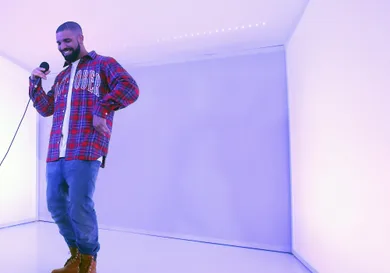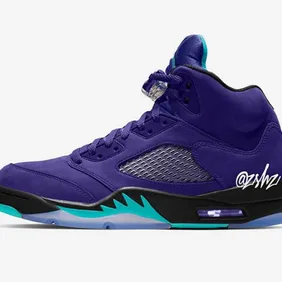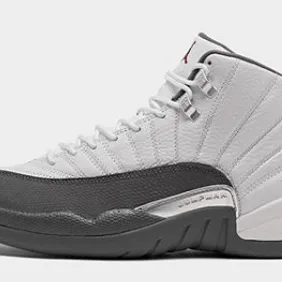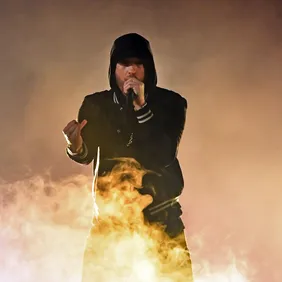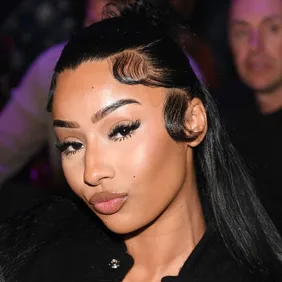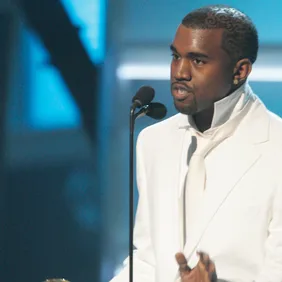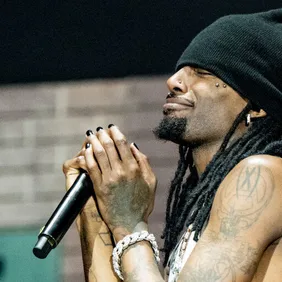In the right hands, everything on the internet can be repurposed. Video snapshots from “This Is America” become gifs which in turn spawn highbrow Vice articles. Song lyrics offer Swiss Army knife capabilities as fratty Instagram captions or outlandish conspiracy theories regarding Drake’s offspring. And Logic interviews become one big biracial joke (with cannibalistic undertones) courtesy of the Muchdank treatment. Hip hop is but one of many portals through which the revolving door of memes has become a social currency, sprinkling blocky “I Love It” Halloween costumes and inexhaustible “I love cheesecake” magic throughout the interwebs. It’s crowdsourced spontaneity that has erected the relationship between popular music and meme culture as the unofficial masthead of the youth. As human attention spans draw ever closer to that of the ill-focused goldfish, humorous and digestible micro-content has sprouted as a novel form of communication. The popular whims of the internet, once trapped in the dungeon of dial-up connections and floppy disks, are now spurred forward through collaborative, community-based participation. Instantaneous word of mouth is the modern assembly line, squeezing every last bit of juice out of pixelated creations in order to remix, repackage, and redistribute at an unprecedented rate.
This quick consumption and dissemination is the latest stage of internet innovation, and has culminated in a music industry paradigm shift of epic proportions. Not only are artists and record labels beginning to formulate songs in the hopes of attaining viral momentum, but they’ve also started fashioning themselves with meme culture in mind. Potent case studies like Tekashi 6ix9ine and Cardi B made fans fall in love with their personalities through social media, to the point that the music became merely a subsidiary of the brand image that they were peddling. “Cash Me Outside” star Bhad Bhabie, Walmart yodeler Mason Ramsey, and the Backpack Kid continue to bludgeon hip hop’s prolific and digitally active fanbase over the head with their engineered meme-ability, generating unique traction in the morass of social media consumerism. Artists are also getting pro bono boosts from platforms like Tik-Tok and content creators such as Lenarr Young, Caleon Fox, Roy Purdy, Daquan, and loveliveserve, whose comment sections have helped monetize associations and, in turn, augmented the traditional methods of musical discovery.
Not only do memes amplify an artist’s online presence, but they can also drive sales, chart positioning, and uncanny longevity. It’s a beneficial partnership evidenced by the success of Blueface’s glock-and-mop shtick, Kodak Black’s studio shimmying “Zeze,” Bobby Shmurda’s hat trick on “Hot N***a,” and Soulja Boy’s second coming as Nintendo’s archenemy. Virality reigns supreme as a promotional tool, as Gunner Safron of Interscope Records mentioned to Pigeons and Planes. “Music is in a place now where it’s almost formatted for utility,” he acknowledged. “A few years ago everyone wanted to get placed on different blogs, and now you want to get on Tumblr pages, on Instagram pages, and showcase your work through third parties where you don’t have to be the leader of the conversation.”
While the plot of A Star Is Born might make for a compelling cinematic experience, grassroots efforts don’t have quite the same pizzazz as they once did. In December 2018, Inzie Records label exec Rojas, who co-produced XXXTentacion’s breakout hit “LOOK AT ME!,” and his business partner Alex “Loyalty” Gelbard fessed to popularizing a ten-step “Pump Plan” designed to transform “a local rapper or minor celebrity into a meme and then a viral sensation using a set of proven marketing tactics.” The supervised arrangement of SoundCloud fame has created a “clout” game bidding war over mugshots and an endless cycle of fabricated beefs that incite controversy and conversation. It should come as no surprise that Rae Sremmurd’s “Black Beatles” craze was a concentrated campaign run by Pizzaslime, a digital brand consultancy hired by Interscope Records to help promote the song on social media that ultimately led to it becoming the unofficial soundtrack of the freeze-frame “Mannequin Challenge.” To quote Frazier Tharpe of Complex, “Once you get on Ellen, you know you’ve really pierced the zeitgeist.”
No one has proven more capable of infiltrating the collective conscience of hip hop heads and suburban soccer moms than Drake. His indulgence of the format, whether it be through a Degrassi reunion or having his dance moves plastered across ugly holiday sweaters, has allowed him to weaponize memes in the name of becoming a trending topic. With the 24-hour media spotlight now completely overclocked, the superstar’s every move is ripe for reappropriation. It’s all part of the package: “Like most things Drake-related, Drake seems to have had a rare gift for landing right at the cross-section of whatever people are talking about.” Even choreographer Tanisha Scott applauded Drake’s Midas touch during the shooting of the “Hotline Bling” video. “We were looking at playbacks, and Drake was like, ‘This is totally going to be a meme’ … He knew what was going to happen.” Hip hop’s commercial king is essentially a walking viral marketing campaign rolled into a likable mass of corny teenage angst and nerdiness. He may be easy to make fun of, but he’s also in on the joke before anyone else can so much as dust off their keyboard and drop in from CN Tower. In a masterful display of “interactive marketing,” the Toronto Raptors gave out OVO-branded lint rollers to 1,200 fans at a home playoff game in 2014 after Drake was caught on camera doing a bit of courtside cleaning. The entire spectrum of emotions can be captured in Drake memes, and a quick glance at The 6 God’s Know Your Meme page reveals the extent of his infiltration of pop culture.
Although unlimited access to Breakfast Club interviews, tender troubleshooting moments between Young Thug and Lil Durk, and takes on Nav’s “Yosemite” verse have opened up a new route to hip hop culture that bypasses cliquey fandoms, it has also created a slippery slope. For better or worse, more casual artists and fans can now afford to delve into the culture ironically and not out of a genuine desire or interest to participate, dealing with the music and the messages behind the music at a distance. Occasionally, the angles are taken too far into the ugliest undercurrents of hip hop homophobia, racism, and misogyny. Artists like XXXTentacion and 6ix9ine blurred the line between the provocative and the outright illegal, thriving on their ability to sow confusion through bold proclamations and trolling. And there is the omnipresent concern that technological progressions have eroded the credibility of the artistic process, as duly noted by J. Cole on “a lot” (“Some n****s make millions, other n****s make memes”). A song may be infectious and zany, but does it possess artistic merit that warrants its popularity? Is hip hop “cheapened by all (the) horseplay” that comes with DJ Khaled broadcasting his jetski misadventure on Snapchat for his 2 million-odd followers?
One thing’s for certain: the internet waits for no one. References become dated the second they storm the beaches of Reddit and KanyeToThe threads. Aspiring artists that piggyback the success of memes are quickly faced with the stark reality of their 15-minutes of fame. Virality can indeed be manufactured by drunken 20-year olds at a house party using a DSLR and a Blue Yeti with a sock for a pop filter, but once it’s released into the wild, there’s no telling which direction it will go. It’s a bizarre ecosystem that will likely continue to evolve and mutate as culture contributors restlessly seek out the next Rick Ross “peargate” or dubbed Sid the Science Kid clip that will make or break careers. If 21 Savage can make ASMR fashionable and Jay-Z can partake in the “Damn Daniel” meme, then truly nothing is off limits.
